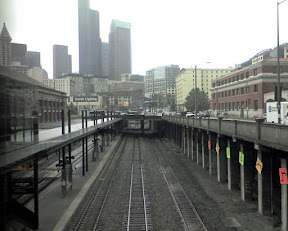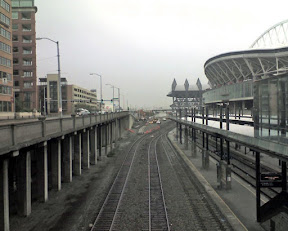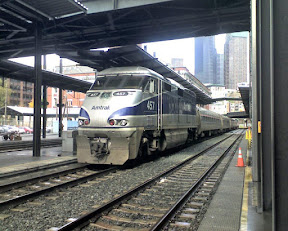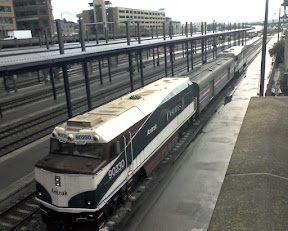 (compare to my big block powered `59 Chevy anyway), and navigates easily around the area. But it's a cage. It's a cage to me because - at 30mph or more - I miss much of what is going on around the streets I drive. There's nothing like walking the same route I've driven, and seeing 10 times more simply because my speed is roughly 3mph instead of 30. For me, walking around downtown Seattle has opened up so much of the city's railroading history that it was simply astounding. During my stint of jury duty downtown, I focused my lunch break attention on King Street Station and the surrounding tracks/roads. I go away with a great understanding of the railroad through this area and its impact on the blocks just south of downtown.
(compare to my big block powered `59 Chevy anyway), and navigates easily around the area. But it's a cage. It's a cage to me because - at 30mph or more - I miss much of what is going on around the streets I drive. There's nothing like walking the same route I've driven, and seeing 10 times more simply because my speed is roughly 3mph instead of 30. For me, walking around downtown Seattle has opened up so much of the city's railroading history that it was simply astounding. During my stint of jury duty downtown, I focused my lunch break attention on King Street Station and the surrounding tracks/roads. I go away with a great understanding of the railroad through this area and its impact on the blocks just south of downtown.
The first picture in today's Then and Now segment was taken in 1948 of Great Northern 1450 on the GN mainline as it is passing underneath Jackson Street. UP's Union Station is situated behind the locomotive, which was shared with the Milwaukee Road (lettering on the right side of the building). An electric trolley runs under wire along Jackson Street to the right. If you look closely in the expanded photo, you will see above the locomotive, standing on the street, a 40s era railfan watching the train...in the same exact spot that I watched several trains go by yesterday. A man on Jackson is also giving the steamer a passing glance.

Thanks to the Sound Transit train station along the mainline, citizens today are able to stand safely along the tracks underneath Jackson to watch trains, although legally I'm not able to take a photo from the same exact spot as the 1948 picture. There are chain link fences and BNSF signs that keep ethical people from breaking the law. Being an honest railfan means following the rules, even if it means you have to give up on the sweet photo op.
So for this installment I have the best possible alternatives - a picture of Union Station in the modern day, a picture of an SD40 passing under Jackson from the other direction, and a picture taken directly under Jackson. For
 perspective the second locomotive with the white face is in roughly the same spot as 1450 was in the first photo. Not surprisingly, the architecture of the overpass hasn't changed; it's pretty crumbly underneath, but if it was unsafe the City of Seattle would shut it down in no time. Standing near the tracks you can see the soot of railroading's decades applied to the ceiling along with passive graffiti on the pillars like "SP&S Dave."
perspective the second locomotive with the white face is in roughly the same spot as 1450 was in the first photo. Not surprisingly, the architecture of the overpass hasn't changed; it's pretty crumbly underneath, but if it was unsafe the City of Seattle would shut it down in no time. Standing near the tracks you can see the soot of railroading's decades applied to the ceiling along with passive graffiti on the pillars like "SP&S Dave."In the 35 minutes that I hung around, two double-stack trains, one mixed freight, and a commuter train switching tracks all made movements along this stretch. Now that I have a better idea on how to use the bus around downtown, it's likely I'll be back to keep up on what's happening along this busy line!













